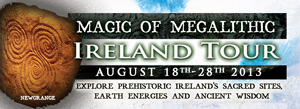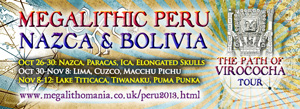2015 Gobekli Tepe tours in May (and September) - more info here
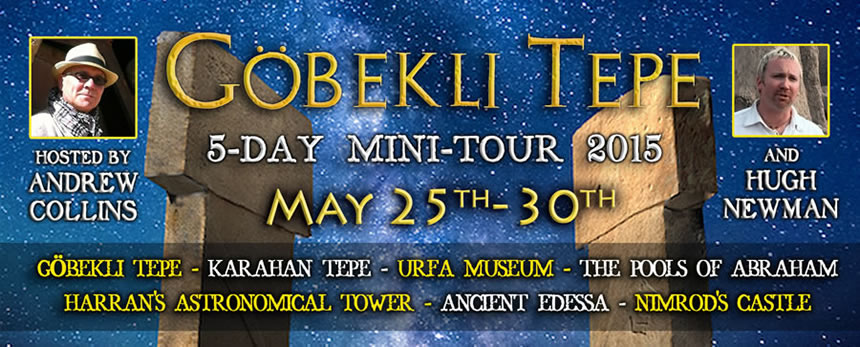
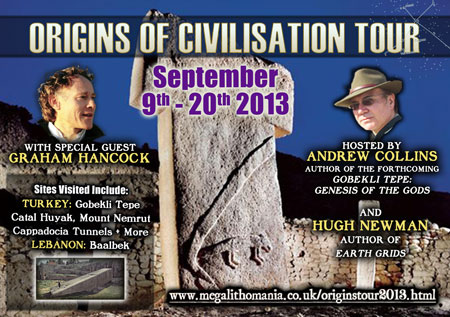 ORIGINS OF CIVILISATION TOUR ORIGINS OF CIVILISATION TOUR
September 9th - 20th 2013 (12 days)
Hosted by Andrew Collins, author of the forthcoming Gobekli Tepe: Genesis of the Gods, plus The Cygnus Mystery and From the Ashes of Angels, alongside Megalithomaniac Hugh Newman, with special guest speaker and best-selling author Graham Hancock.
NEW: We are very pleased to announce that Graham Hancock and his wife Santha will be joining us for some sectors of the tour. While he is with us Graham will offer evening lectures to the group and will be fully available for discussion and interaction. He will be researching for his new book Magicians of the Gods.
The breath-taking plains and steppes of eastern Turkey, the traditional Garden of Eden or terrestrial Paradise, was the setting for the Neolithic revolution and the rise of civilisation. Join Andrew Collins and Megalithomania on its unique tour of the Cradle of Civilisation. Visit some of the world’s most exciting archaeological sites including Göbekli Tepe, the oldest stone temple complex, the ancient city of Harran, the Temple of Baalbek in Lebanon, and Çatal Höyük, the world’s first city. See also the city of Konya, home of the Whirling Dervishes; Alaca Hoyuk, that has incredible megalithic polygonal masonry similar to Peru, Sanliurfa, the ancient Christian city of Edessa, birthplace of Abraham; and the traditional area of the Garden of Eden, home of the Watchers and Nephilim of the book of Enoch, and the Annunaki of Sumerian myth and legend. Both Andrew and Hugh will be presenting evening lectures throughout the tour, plus they will be discussing theories and new research on site. We are hoping to meet Klaus Schmit, the primary achaeologist at Gobekli Tepe, who carbon dated the site back to around 10,000 BC. Please note we are doing the tour as ONE TOUR, not separate tours to Turkey and Lebanon. So please be aware of that when booking.
Tour Costs:
£2295 (meet Istanbul)
based on double occupancy
Single occupancy supplement: £370 - Tour deposit: £400
Please email info@megalithomania.co.uk
for more info |
Click here to pay £400 deposit to confirm your place:

|
Proposed Itinerary: September 2013 - subject to change
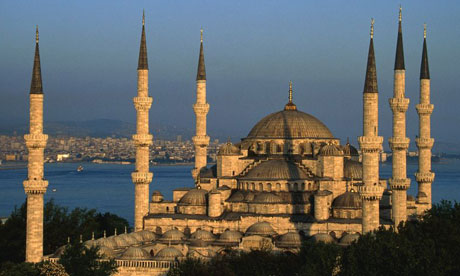 Day 1 - September 9th (arrival day): Day 1 - September 9th (arrival day):
Arrive directly in Istanbul. Pick up at airport & to hotel. Evening orientation with Andrew & Hugh
Day 2 - September 10th:
After breakfast, we will visit the Sultanahmet district, called the “historical peninsula”. First we will visit Ottoman ruins and after that the Blue mosque, the most important mosque in Istanbul with its more than 20,000 handmade ceramic tiles and 200 stained glass windows. Visit Byzantine monuments including the St. Sophia Museum (Hagia Sophia, the former Byzantine Church) – the greatest example of Byzantine architecture. Then we will see the Basilica Cistern, which was the main water provider for “Constantinople”, and we will also see the Byzantine Hippodrome where we will view beautiful obelisks and columns from the Egyptian, Greek, and Roman periods. Transfer to the airport for a flight to Ankara. Overnight in Ankara.
Day 3 - September 11th:
Drive to and visit Hattusa and Alaca Hoyuk (both pictured below). They both have impressive megalithic stonework. Hattusa was once the centre of the Hittite Empire, dating back to the late Bronze Age. Set in what were once rich agricultural fields and among scenic, rolling hills, the city has some fine examples of early ancient architecture. Originally the inner city was a vast array of temples and monuments, overlooked by the royal residence on the acropolis. An architectural masterpiece in its time, the city gateway was once adorned with reliefs of warriors, lions and sphinxes, framing four temples, each of which had their own courtyard. The city was destroyed, along with the Hittites themselves, in the 12th century BC. By the 20th century, the principal remains of Hittite inscriptions were found on over 10,000 tablets.
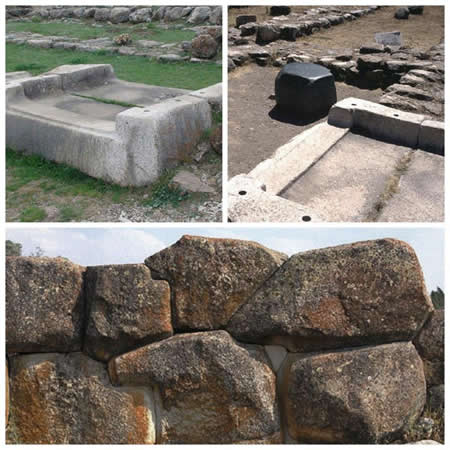
Alaca Hoyuk has incredible polygonal megalithic masonry very similar to that in Peru and Italy (see above), and although it is a Hittite site, it may date back much earlier. Drive to Cappadocia for overnight.
Days 4 and 5 - September 12th/13th:
 Visit Goreme, capital of Turkey’s eastern province of Cappadocia, with its lunar landscape dominated by conical rock towers known as Fairy Chimneys. See Goreme’s rock-cut churches, with their strange art with its origins in the prehistoric age. Visit the enigmatic underground city of Derinkiyu, constructed perhaps as early as the last Ice Age. Devrent Valley is home to the famous Fairy Chimneys near Goreme and is known as the imaginary valley or animal valley due to the animal shapes in rocks. While Fairy chimneys can be found in much of Cappadocia, these are the best formed and most densely clustered. The volcanic rock of this area has allowed erosion to form these chimneys as well as other landforms such as caves, clefts and folds in the rock, making this breathtaking landscape unique. A thick layer of tuff (consolidated volcanic ash) is covered by a thinner layer of basalt which is more resistant to erosion than the underlying rock. Cracks in the basalt enable erosion of the underlying rock. These fairy chimneys were formed where the resistant rock remains protecting the underlying rock directly beneath it from erosion. The mineral-rich volcanic soil is excellent for growing fruit and vegetables, making Cappadocia a rich agricultural region. It has always been one of Anatolia's prime grape-growing areas, and still boasts many Visit Goreme, capital of Turkey’s eastern province of Cappadocia, with its lunar landscape dominated by conical rock towers known as Fairy Chimneys. See Goreme’s rock-cut churches, with their strange art with its origins in the prehistoric age. Visit the enigmatic underground city of Derinkiyu, constructed perhaps as early as the last Ice Age. Devrent Valley is home to the famous Fairy Chimneys near Goreme and is known as the imaginary valley or animal valley due to the animal shapes in rocks. While Fairy chimneys can be found in much of Cappadocia, these are the best formed and most densely clustered. The volcanic rock of this area has allowed erosion to form these chimneys as well as other landforms such as caves, clefts and folds in the rock, making this breathtaking landscape unique. A thick layer of tuff (consolidated volcanic ash) is covered by a thinner layer of basalt which is more resistant to erosion than the underlying rock. Cracks in the basalt enable erosion of the underlying rock. These fairy chimneys were formed where the resistant rock remains protecting the underlying rock directly beneath it from erosion. The mineral-rich volcanic soil is excellent for growing fruit and vegetables, making Cappadocia a rich agricultural region. It has always been one of Anatolia's prime grape-growing areas, and still boasts many 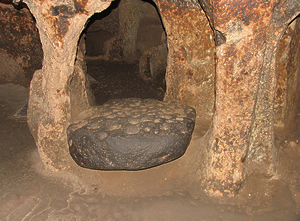 productive vineyards and wineries. The Bible's New Testament tells of Cappadocia, but in fact this part of central Anatolia has been important since Hittite times, long before the time of Jesus. productive vineyards and wineries. The Bible's New Testament tells of Cappadocia, but in fact this part of central Anatolia has been important since Hittite times, long before the time of Jesus.
There are 36 underground cities in Cappadocia and the widest one is Kaymakli underground city. These troglodyte cave-cities were excavated as early as Hittite times, and expanded over the centuries as various pillaging armies crossed Central Anatolia in search of captives and plunder. The Kaymakli Underground City has low, narrow and sloping passages and consists of 8 floors below ground, although only four of them are open to the public today. The number of the storage rooms in such a small area supports the idea that a great number of people resided here. Archaeologists think that this could have been up to three thousand five hundred people. As well as chapels, stables and storage, an efficient man-made system of air shafts provided ventilation even at the deepest levels of the underground cities so they were able to survive there for lengths of time when necessary.

The people of Kaymakli village have constructed their houses above nearly one hundred tunnels of the underground city. The inhabitants of the region still use the most convenient places in the tunnels as cellars, storage areas and stables, which they access through their courtyards. Ortahisar is another Cappadocian village dominated by a fortress-like rock rising above winding roads. The 90m high natural fortress in Ortahisar has partly crumbled away revealing some of its interior. Today it has been restored and the peak is accessible by a staircase. The Ortahisar Castle offers a magnificent panorama over the fairy chimneys of Hallacdere and the snowy peak of Mt. Erciyes.Meals: B, L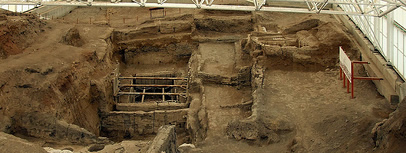
Day 6 - September 14th:
Visit Çatal Höyük, The worlds oldest city, then return to Konya for a tour around its archaeological museum, with its spectacular Çatal Höyük exhibition. In the evening head into downtown Konya to see a performance of the mesmerizing Whirling Dervishes - Optional. Meals: B, L
Day 7 - September 15th:
Drive to Gaziantep (7 hours driving). Visit the Museum of Archaeology where some unusual T-shaped pillars are on display, similar in style to Gobekli Tepe. Overnight in Gaziantep.
Day 8 - September 16th:
Journey on to Sanliurfa (Urfa), the biblical city of Edessa. Visit Göbekli Tepe, the world’s oldest stone temple complex, constructed nearly 12,000 years ago, making it the oldest megalithic site on the planet. See its extraordinary rings of T-shaped standing stones with carved reliefs of birds, animals and other abstract forms. Learn its history and place in the origins of civilization.
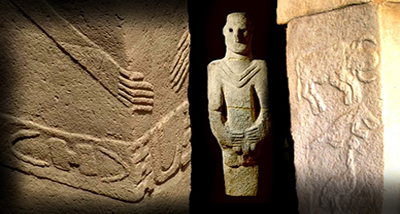
Göbekli Tepe, the oldest place of worship in the world, is an archaeological site without equal. Prior to its discovery in 1994 and its subsequent excavation it was widely believed by anthropologists that religion evolved as a result of living in larger communities which was itself the result of the change from foraging to agriculture. However Göbekli Tepe has turned our theories of our own evolution on their head. The vast religious site dates from the hunter gatherer period and there is no evidence of any agriculture or even human habitation suggesting that it may have been the emergence of religion that lead us to civilisation and thus to agriculture. It is hard to overestimate the significance of this finding.
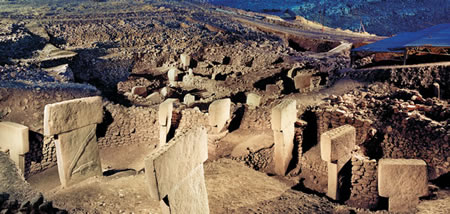
The site contains a vast array of circular structures and huge pillars, some with beautiful limestone carvings of lions, foxes, snakes and birds, believed to be gatekeepers of the entrance to the next world. There are striking similarities to sites in Peru, Bolivia and Easter Island that were noted by Robert Schoch in the Megalithomania expedition in November 2012. To date less than ten percent of the site has been excavated. 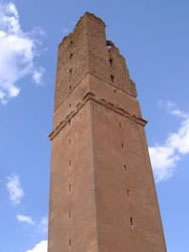
Visit also the ancient city of Harran, once the centre of Egypt’s Hermetic tradition. See its ominous “Astronomical Tower”, citadel and local village, and take in one of the most atmospheric sites anywhere in the world. Urfa (a.k.a. Sanliurfa, “the prophet’s city”, or Edessa in ancient times) is the most spiritual city in East Turkey. It is a major centre for pilgrimage and its traditions are very much alive and well. The “Sanli-“ part of its name (meaning “great” or “dignified”) was awarded by the Turkish legislature in 1984 in recognition of the city’s pivotal role in the Turkish war of Independence. Of particular note for visitors are Urfa castle (the current walls were constructed by the Abbasids in 814AD), the Pool of Sacred Fish where Abraham was thrown into the fire by Nimrod, the park of mosques, the market area and Urfa museum. Mentioned in the book of Genesis, Harran is believed to have once been home to the Prophet Abraham. The site of the first Islamic university in Anatolia, Harran also boasts the remains of an 8th century mosque, a citadel and some 300 year old beehive mud homes. Meals: B, L
Day 9 - September 17th:
Today we shall visit Gobekli Tepe in the morning to get a real taste of this incredible site with time for meditation and freedom to explore the site alone. Visit the archaeological museum, with its compelling exhibition of artefacts from Göbekli Tepe. Drive to Mount Nemrut. Overnight near Mount Nemrut.
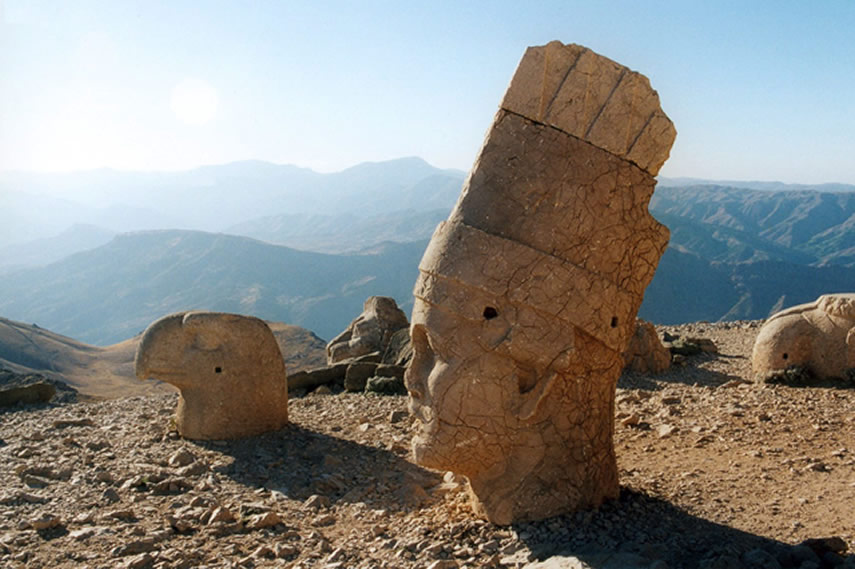
Day 10 - September 18th:
Early morning visit to Nemrut Dagi (Nimrod’s Mountain), the site of the original Tower of Babel and Mountain of God of biblical tradition. Gaze out over the terrestrial Paradise as enjoyed by the biblical patriarchs of the book of Genesis. Mount Nemrut (a.k.a. Nemrut Dagi) is the perfect place to experience a sunrise or sunset. One of East Turkey’s most spell-binding attractions at the peak of this mountain (at over 2000m) sit enigmatic statues of a pre-Roman king, Antiochus I Theos of Commagene, and the various gods he believed to be his ancestors. The views from the summit are sublime. (NOTE it is a 20-30 minute walk up steps to reach the summit). Back to hotel for a rest before continuing to Adiyamin. Fly from Adiyamin airport via Istanbul to Beirut. Overnight in Beirut. Meals: B, L
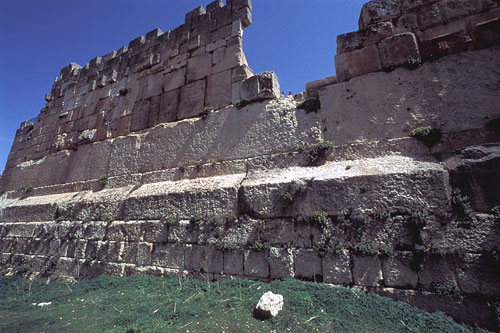 Day 11 - September 19th: Day 11 - September 19th:
Visit Baalbek’s grand Temple of Baal-Haman, containing the three largest building blocks ever used for building construction. At an unbelievable 800-1000 tonnes a piece they are gigantic, and yet are dwarfed by a cut and dressed stone block ready for transportation in a nearby quarry. Known as the Stone of the Pregnant Woman, it is estimated to be as much 1200 tonnes in weight. For centuries the temples of Baalbek (a.k.a the “Sun City”) lay under metres of rubble, obscured by medieval fortifications. Excavation andrestoration work began in 1898 however and it has since been recognized as hugely important in Roman history as it acts as a model of Imperial Roman architecture. It is probably the most important Roman site in the whole of the Middle East. Baalbek's temples were built on an ancient temple that goes back at least to the end of the third millennium B.C. The temple was begun in the last quarter of the 1st century B.C., and was finished by the 3rd century AD. The temples were closed in 313 AD when Christianity became the Roman Empire’s official religion. Baalbek’s collection of stunning temples, mosques, courtyards and statues are a must for any visit to Lebanon. Return to Beirut for overnight. Meals: B
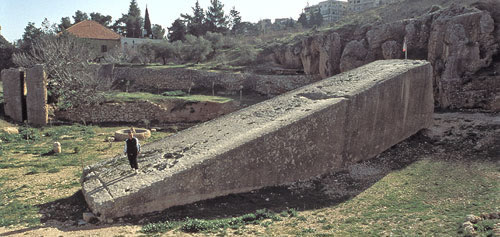
Day 12 - September 20th (Departure day):
Beirut stands on the site of a very ancient settlement going back at least five thousand years. In the first century B.C., it became a Roman Colony with the name of Berytus, whose power was destroyed by an earthquake, tidal wave and fire in 551 A.D. 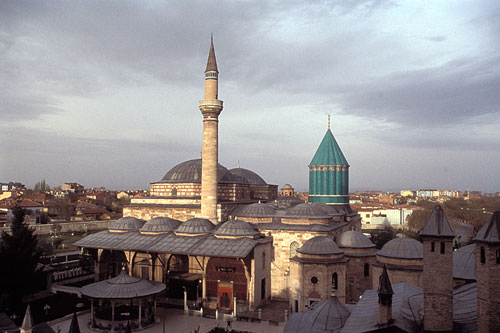 In the following century Arab Muslim forces took the city and in 1110 it fell to the Crusaders. In 1291 itwas conquered by the Mamlukes. Ottoman rule began in 1516 and lasted for 400 years until the defeat of the Turks in World War I. The French Mandate Period followed and in 1943 Lebanon gained its independence. Set between the Mediterranean and dramatic mountains rising up in the background, Beirut is one of the Middle East’s most lively cities. The rejuvenation of the Beirut Central District is one of the largest, most ambitious urban redevelopment projects ever undertaken. While Beirut has become one of the Middle East’s most modern cities, it still maintains its fascinating history and beautiful sites, as well as a thriving arts scene. Until the civil war ended in 1990, most of the archaeological sites discovered were found by accident. However, since then there have been excavations to uncover and investigate these phenomenal sites. The Green Line was a line of separation between the Muslims in West Beirut and the Christian front in East Beirut. It was green because it was uninhabited and therefore covered in vegetation. The local people are renowned for being extremely friendly and charming. Meals: B In the following century Arab Muslim forces took the city and in 1110 it fell to the Crusaders. In 1291 itwas conquered by the Mamlukes. Ottoman rule began in 1516 and lasted for 400 years until the defeat of the Turks in World War I. The French Mandate Period followed and in 1943 Lebanon gained its independence. Set between the Mediterranean and dramatic mountains rising up in the background, Beirut is one of the Middle East’s most lively cities. The rejuvenation of the Beirut Central District is one of the largest, most ambitious urban redevelopment projects ever undertaken. While Beirut has become one of the Middle East’s most modern cities, it still maintains its fascinating history and beautiful sites, as well as a thriving arts scene. Until the civil war ended in 1990, most of the archaeological sites discovered were found by accident. However, since then there have been excavations to uncover and investigate these phenomenal sites. The Green Line was a line of separation between the Muslims in West Beirut and the Christian front in East Beirut. It was green because it was uninhabited and therefore covered in vegetation. The local people are renowned for being extremely friendly and charming. Meals: B
Tour Ends. Fly from Beirut to Istanbul
Price includes
- All transportation including internal flights
- Internation flight to Lebanon from Turkey
- All bus travel and accommodation
- English-speaking guides
- Entrances to sites and museums
- All VAT and local taxes
- Breakfasts
- Lunches & Dinners as stated in itinerary (L,D)
Price does not include
- Visas
- Tips and items of personal nature
- Any meals or activities not included in the programme
- International Flights |
 
|
Photo credit: Martin Gray - www.sacredsites.com. Andrew Collins - www.andrewcollins.com and PDPhoto.org
Contact and info email HERE |

 ORIGINS OF CIVILISATION TOUR
ORIGINS OF CIVILISATION TOUR
 Day 1 - September 9th (arrival day):
Day 1 - September 9th (arrival day): 
 Visit Goreme, capital of Turkey’s eastern province of Cappadocia, with its lunar landscape dominated by conical rock towers known as Fairy Chimneys. See Goreme’s rock-cut churches, with their strange art with its origins in the prehistoric age. Visit the enigmatic underground city of Derinkiyu, constructed perhaps as early as the last Ice Age. Devrent Valley is home to the famous Fairy Chimneys near Goreme and is known as the imaginary valley or animal valley due to the animal shapes in rocks. While Fairy chimneys can be found in much of Cappadocia, these are the best formed and most densely clustered. The volcanic rock of this area has allowed erosion to form these chimneys as well as other landforms such as caves, clefts and folds in the rock, making this breathtaking landscape unique. A thick layer of tuff (consolidated volcanic ash) is covered by a thinner layer of basalt which is more resistant to erosion than the underlying rock. Cracks in the basalt enable erosion of the underlying rock. These fairy chimneys were formed where the resistant rock remains protecting the underlying rock directly beneath it from erosion. The mineral-rich volcanic soil is excellent for growing fruit and vegetables, making Cappadocia a rich agricultural region. It has always been one of Anatolia's prime grape-growing areas, and still boasts many
Visit Goreme, capital of Turkey’s eastern province of Cappadocia, with its lunar landscape dominated by conical rock towers known as Fairy Chimneys. See Goreme’s rock-cut churches, with their strange art with its origins in the prehistoric age. Visit the enigmatic underground city of Derinkiyu, constructed perhaps as early as the last Ice Age. Devrent Valley is home to the famous Fairy Chimneys near Goreme and is known as the imaginary valley or animal valley due to the animal shapes in rocks. While Fairy chimneys can be found in much of Cappadocia, these are the best formed and most densely clustered. The volcanic rock of this area has allowed erosion to form these chimneys as well as other landforms such as caves, clefts and folds in the rock, making this breathtaking landscape unique. A thick layer of tuff (consolidated volcanic ash) is covered by a thinner layer of basalt which is more resistant to erosion than the underlying rock. Cracks in the basalt enable erosion of the underlying rock. These fairy chimneys were formed where the resistant rock remains protecting the underlying rock directly beneath it from erosion. The mineral-rich volcanic soil is excellent for growing fruit and vegetables, making Cappadocia a rich agricultural region. It has always been one of Anatolia's prime grape-growing areas, and still boasts many  productive vineyards and wineries. The Bible's New Testament tells of Cappadocia, but in fact this part of central Anatolia has been important since Hittite times, long before the time of Jesus.
productive vineyards and wineries. The Bible's New Testament tells of Cappadocia, but in fact this part of central Anatolia has been important since Hittite times, long before the time of Jesus. 






 In the following century Arab Muslim forces took the city and in 1110 it fell to the Crusaders. In 1291 itwas conquered by the Mamlukes. Ottoman rule began in 1516 and lasted for 400 years until the defeat of the Turks in World War I. The French Mandate Period followed and in 1943 Lebanon gained its independence. Set between the Mediterranean and dramatic mountains rising up in the background, Beirut is one of the Middle East’s most lively cities. The rejuvenation of the Beirut Central District is one of the largest, most ambitious urban redevelopment projects ever undertaken. While Beirut has become one of the Middle East’s most modern cities, it still maintains its fascinating history and beautiful sites, as well as a thriving arts scene. Until the civil war ended in 1990, most of the archaeological sites discovered were found by accident. However, since then there have been excavations to uncover and investigate these phenomenal sites. The Green Line was a line of separation between the Muslims in West Beirut and the Christian front in East Beirut. It was green because it was uninhabited and therefore covered in vegetation. The local people are renowned for being extremely friendly and charming. Meals: B
In the following century Arab Muslim forces took the city and in 1110 it fell to the Crusaders. In 1291 itwas conquered by the Mamlukes. Ottoman rule began in 1516 and lasted for 400 years until the defeat of the Turks in World War I. The French Mandate Period followed and in 1943 Lebanon gained its independence. Set between the Mediterranean and dramatic mountains rising up in the background, Beirut is one of the Middle East’s most lively cities. The rejuvenation of the Beirut Central District is one of the largest, most ambitious urban redevelopment projects ever undertaken. While Beirut has become one of the Middle East’s most modern cities, it still maintains its fascinating history and beautiful sites, as well as a thriving arts scene. Until the civil war ended in 1990, most of the archaeological sites discovered were found by accident. However, since then there have been excavations to uncover and investigate these phenomenal sites. The Green Line was a line of separation between the Muslims in West Beirut and the Christian front in East Beirut. It was green because it was uninhabited and therefore covered in vegetation. The local people are renowned for being extremely friendly and charming. Meals: B

